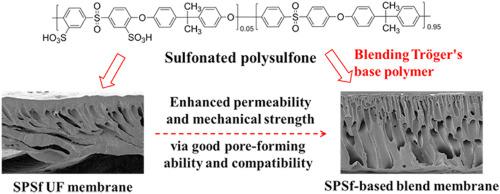Journal of Membrane Science ( IF 8.4 ) Pub Date : 2021-02-09 , DOI: 10.1016/j.memsci.2021.119138 Jiulong Yin , Hai Tang , Zhaozan Xu , Nanwen Li

|
To improve the mechanical strength and separation performance of sulfonated polysulfone (SPSf) ultrafiltration membranes, Tröger's base (TB) polymer was blended into the casting solution. An acid-base crosslinking structure between the sulfonic acid groups of SPSf and tertiary amine groups in TB would contribute to their good compatibility and influence the membrane formation process, morphology and properties. The formation of acid-base pairs was confirmed by the existence of quaternary amine groups in the X-ray photoelectron spectra of SPSf/TB blend membranes. According to the pore structure analysis of ultrafiltration membranes, the blending of TB polymer into SPSf enhanced the surface and total porosities, and reduced the top layer thickness. In addition, the finger-like pores became more regular and vertically interconnected. The SPSf/TB blend membrane showed a higher water contact angle than SPSf membrane due to the addition of hydrophobic TB polymer and formation of acid-base crosslinking structure. The SPSf/TB blend membranes showed higher pure water fluxes (127.4–342.7 L m−2 h−1) than the SPSf membrane (51.6 L m−2 h−1). All membranes showed similar retention factor for bovine serum albumin (BSA), a model protein foulant. In static experiments, the amount of BSA adsorbed by the SPSf/TB blend membranes was much lower than that of the pristine SPSf membrane because the enhanced charge of the blend membranes (ζ = −72.46 ~ −79.17 mV) strengthened the electrostatic repulsion between membrane surface and BSA. The flux recovery ratio after three ultrafiltration cycles using SPSf/TB blend membranes was lower than that of SPSf membrane because pore blockage and irreversible pollution occurred more easily under a high flux, larger average pore size, and lower hydrophilicity. The introduction of TB polymer enhanced the mechanical strength of the ultrafiltration membrane due to the formation of acid-base crosslinking structure between TB polymer and SPSf.
中文翻译:

增强的磺化聚砜/Tröger基础聚合物共混物超滤膜的机械强度和性能
为了提高磺化聚砜(SPSf)超滤膜的机械强度和分离性能,将Tröger的基础(TB)聚合物共混到流延溶液中。SPSf的磺酸基团与TB中的叔胺基团之间的酸碱交联结构将有助于它们的良好相容性并影响膜的形成过程,形貌和性能。通过SPSf / TB共混膜的X射线光电子能谱中存在季胺基团,证实了酸碱对的形成。根据超滤膜的孔结构分析,将TB聚合物共混到SPSf中可提高表面和总孔隙率,并降低顶层厚度。另外,手指状的孔变得更加规则和垂直互连。SPSf / TB共混膜的疏水性比SPSf膜高,这是因为添加了疏水性TB聚合物并形成了酸碱交联结构。SPSf / TB混合膜的纯水通量更高(127.4–342.7 L m-2 h -1)比SPSf膜(51.6 L m -2 h -1)。所有膜对牛血清白蛋白(BSA)(一种模型蛋白质污垢)均显示出相似的保留因子。在静态实验中,SPSf / TB共混膜吸附的BSA量远低于原始SPSf膜,因为共混膜电荷的增加(ζ= -72.46〜-79.17 mV)增强了膜之间的静电排斥力表面和BSA。使用SPSf / TB共混膜的三个超滤循环后的通量回收率比SPSf膜低,这是因为在高通量,较大的平均孔径和较低的亲水性下,孔堵塞和不可逆污染更容易发生。TB聚合物的引入由于在TB聚合物和SPSf之间形成了酸碱交联结构而增强了超滤膜的机械强度。











































 京公网安备 11010802027423号
京公网安备 11010802027423号